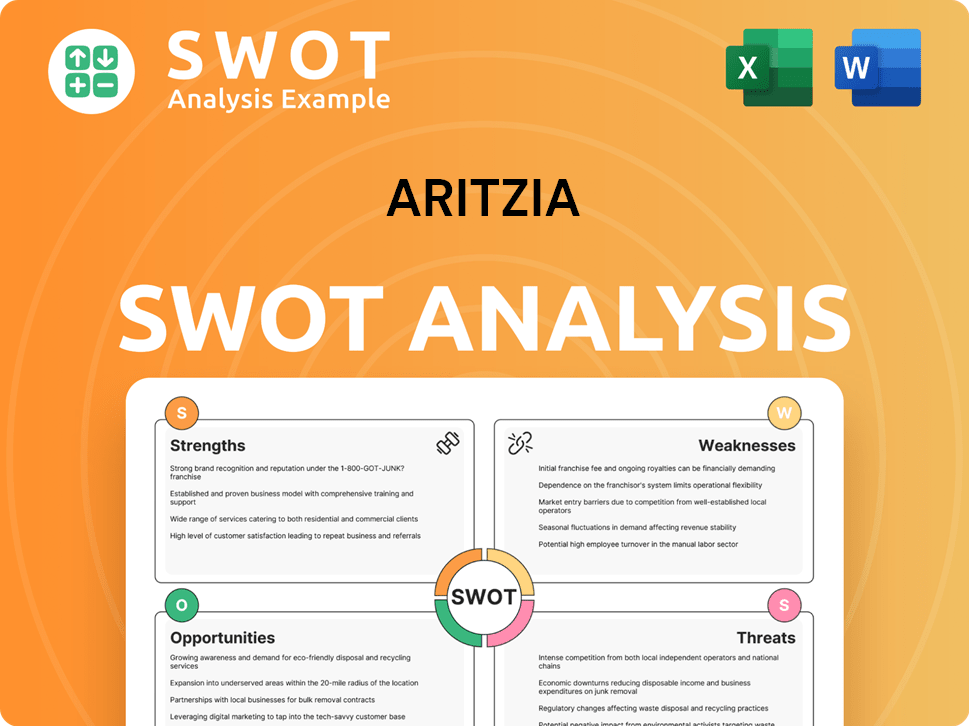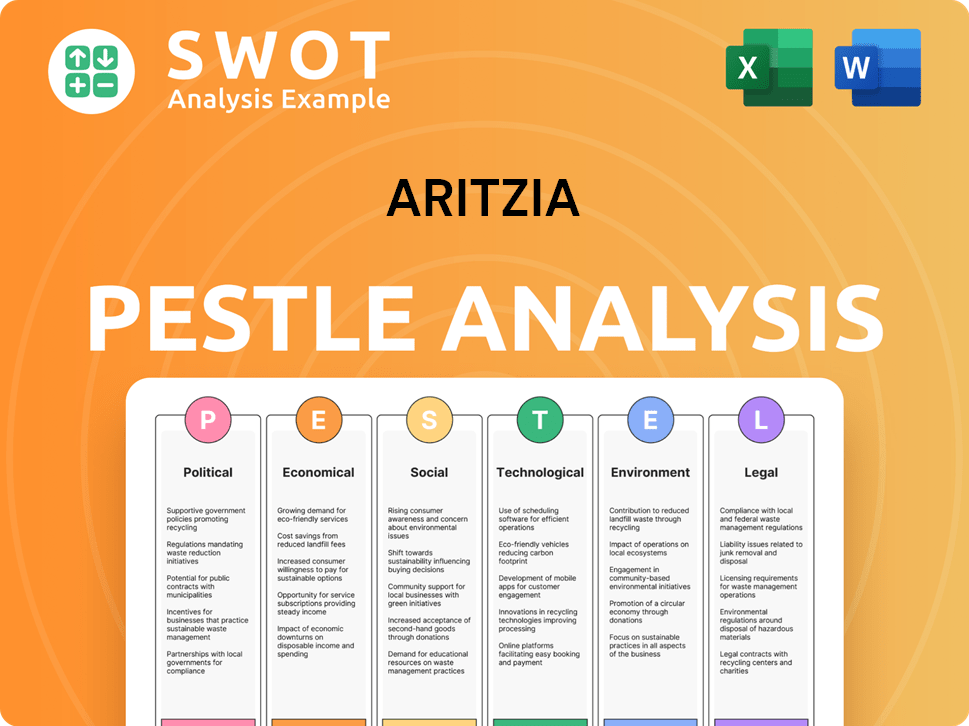Aritzia Bundle
Who Really Owns Aritzia?
Understanding the Aritzia owner structure is crucial for any investor or business strategist. From its humble beginnings to its current status as a publicly traded company, the journey of Aritzia's ownership reveals a fascinating story of growth and strategic evolution. Discover the key players and pivotal moments that have shaped the Aritzia brand.

Founded in 1984 by Brian Hill, Aritzia has become a prominent name in the fashion industry. Its initial public offering (IPO) in 2016 marked a significant shift in its ownership structure, opening doors to a wider investor base. This article will explore the intricate details of Aritzia SWOT Analysis and who owns Aritzia, including its shareholders and the influence of its leadership team, providing a comprehensive look at the Aritzia company's ownership dynamics.
Who Founded Aritzia?
The story of Aritzia's ownership begins in 1984 with its founder, Brian Hill. He launched the first standalone boutique in Vancouver, Canada, marking the start of a brand that would become a significant player in the fashion industry. The company emerged from the foundation of the Hill family's existing department store business.
Brian Hill's vision was centered on offering 'beautiful clothes in aspirational spaces with exceptional service.' This focus helped to define the company's initial strategy and brand identity. The aim was to bridge the gap between the junior fashion market and luxury offerings, focusing on unique and high-quality pieces.
While specific ownership details from its inception are not publicly available, Brian Hill and his family were the primary owners. As the company grew, it developed its own in-house brands, such as Babaton, TNA, and Wilfred. These brands now account for over 90% of its sales, demonstrating a strong vertically integrated model from the beginning.
The company was founded in 1984 by Brian Hill. He opened the first boutique in Vancouver, Canada.
Aritzia aimed to fill the gap between the junior fashion market and luxury offerings. They focused on unique and high-quality pieces.
Aritzia developed in-house brands like Babaton, TNA, and Wilfred. These now make up over 90% of sales.
Brian Hill and his family were the foundational owners. There is no public information about early investors.
The company's early focus on in-house brands allowed for control over product and brand. This approach helped maintain higher profit margins.
The company began developing its own in-house brands in the late 1990s. This strategy supported national expansion.
The early ownership structure of the Aritzia company was primarily held by the founder, Brian Hill, and his family. This structure allowed for a focused approach to building the brand. For more details, you can read a brief history of Aritzia.
Here are some key points about the early ownership and structure of the company:
- Brian Hill founded the company in 1984.
- The company focused on unique, high-quality pieces.
- In-house brands now account for over 90% of sales.
- The Hill family was the primary owner in the early stages.
- Vertical integration allowed for control over product and brand.
Aritzia SWOT Analysis
- Complete SWOT Breakdown
- Fully Customizable
- Editable in Excel & Word
- Professional Formatting
- Investor-Ready Format

How Has Aritzia’s Ownership Changed Over Time?
The ownership structure of the Aritzia company underwent a significant transformation with its Initial Public Offering (IPO) on October 3, 2016, on the Toronto Stock Exchange (TSX). The IPO involved a secondary offering of subordinate voting shares by entities controlled by Brian Hill, the founder, and Berkshire Partners LLC, a private equity firm. The shares were priced at $16.00 per share, generating gross proceeds of C$460 million for the selling shareholders. This marked the largest Canadian IPO in 2016.
Following the IPO, the company adopted a dual-class share structure, ensuring the founder retained substantial control. As of April 30, 2025, Brian Hill, the principal shareholder, Founder, and Executive Chair, held or controlled all 19,679,244 multiple voting shares. These shares grant ten votes per share, giving Hill approximately 67.5% of the total voting power as of February 25, 2025. There were 94,751,567 subordinate voting shares outstanding as of April 30, 2025, each with one vote.
| Shareholder | Shares Held (as of May 30, 2025) | Notes |
|---|---|---|
| Brian Hill | 19,679,244 (Multiple Voting Shares) | Founder and Executive Chair, controls approximately 67.5% of total voting power. |
| Fidelity Blue Chip Growth Fund (FBGRX) | Data not available | Major institutional investor. |
| Vanguard Total International Stock Index Fund Investor Shares (VGTSX) | Data not available | Major institutional investor. |
| Fidelity Retailing Portfolio (FSRPX) | Data not available | Major institutional investor. |
Major institutional investors include Fidelity Blue Chip Growth Fund (FBGRX), Vanguard Total International Stock Index Fund Investor Shares (VGTSX), and Fidelity Retailing Portfolio (FSRPX) as of May 30, 2025. These institutions collectively held a total of 17,576,557 shares. Berkshire Partners, a major shareholder before the IPO, exited its stake in 2019. The dual-class structure allows Brian Hill to maintain significant influence over the company's strategy and governance. For a deeper dive into the competitive landscape, consider exploring the Competitors Landscape of Aritzia.
Aritzia's ownership is primarily controlled by its founder, Brian Hill, through a dual-class share structure.
- The IPO in 2016 marked a significant shift in the company's ownership.
- Institutional investors hold a substantial portion of the subordinate voting shares.
- Berkshire Partners, a former major shareholder, exited its position in 2019.
- The dual-class structure ensures founder control despite being a public company.
Aritzia PESTLE Analysis
- Covers All 6 PESTLE Categories
- No Research Needed – Save Hours of Work
- Built by Experts, Trusted by Consultants
- Instant Download, Ready to Use
- 100% Editable, Fully Customizable

Who Sits on Aritzia’s Board?
As of July 10, 2024, the board of directors of the Aritzia company included Brian Hill, the Founder and Executive Chair, spearheading the company's long-term strategies. Jennifer Wong, who became CEO in May 2022, also remains on the board. Other board members included Aldo Bensadoun, John Currie, Daniel Habashi, David Labistour, John Montalbano (who stepped down effective February 17, 2025), Marni Payne, Glen Senk, and Marcia Smith. This composition reflects a blend of experience and strategic vision, crucial for guiding the Aritzia brand.
Brian Hill's continued role as Executive Chair ensures his founding vision remains central to the company's direction. The board's diverse expertise supports Aritzia's growth and operational excellence. The composition of the board is key to the company's governance and strategic oversight, influencing its performance and future initiatives. This structure helps in maintaining a balance between founder influence and independent oversight.
| Board Member | Title | Role |
|---|---|---|
| Brian Hill | Founder and Executive Chair | Drives long-term growth |
| Jennifer Wong | CEO | Strategic Leadership |
| Aldo Bensadoun | Board Member | Provides experience |
| John Currie | Board Member | Provides experience |
| Daniel Habashi | Board Member | Provides experience |
| David Labistour | Board Member | Provides experience |
| Marni Payne | Board Member | Provides experience |
| Glen Senk | Board Member | Provides experience |
| Marcia Smith | Board Member | Provides experience |
The voting power within Aritzia is significantly influenced by its dual-class share structure. As of April 30, 2025, Brian Hill, through entities he controls, holds all of the 19,679,244 multiple voting shares, each providing ten votes. This grants him approximately 67.5% of the total voting power, despite his equity interest being around 17.2% following a secondary offering in February 2025. The subordinate voting shares, numbering 94,751,567 outstanding as of April 30, 2025, carry one vote per share. This structure ensures that Brian Hill maintains significant control over major decisions. For more insights into the company's strategic direction, consider reading about the Growth Strategy of Aritzia.
Understanding the ownership structure of Aritzia is crucial for investors and stakeholders.
- Brian Hill, the founder, retains significant voting power.
- The dual-class share structure concentrates control.
- The board of directors includes experienced members guiding the company.
- Aritzia's ownership is structured to ensure founder influence.
Aritzia Business Model Canvas
- Complete 9-Block Business Model Canvas
- Effortlessly Communicate Your Business Strategy
- Investor-Ready BMC Format
- 100% Editable and Customizable
- Clear and Structured Layout

What Recent Changes Have Shaped Aritzia’s Ownership Landscape?
Over the past few years, the ownership structure of the company has seen notable shifts. In January 2024, the company initiated a Normal Course Issuer Bid (NCIB) to repurchase shares, aiming to cancel up to 3,515,740 subordinate voting shares by January 21, 2025. By March 2, 2025, the company had repurchased 134,200 shares at an average price of $44.00 per share, totaling $5.9 million. A new NCIB for 2025 is anticipated to commence around May 7, 2025, allowing for the purchase of up to 5% of the public float of subordinate voting shares. This demonstrates a commitment to returning value to shareholders and managing the share count.
A significant change occurred in February 2025, with a secondary offering of 1,045,000 subordinate voting shares by entities controlled by Brian Hill and his family. This offering generated gross proceeds of $73.0 million for the selling shareholders, with shares priced at $69.85 each. Despite the sale, Brian Hill remained the largest shareholder, holding approximately a 17.2% equity interest. These actions reflect ongoing adjustments within the company's ownership, influenced by market dynamics and strategic decisions.
| Metric | Fiscal 2025 | Fiscal 2024 |
|---|---|---|
| Net Revenue | $2.74 billion | $2.33 billion |
| Net Income | $207.8 million | $78.8 million |
| U.S. Net Revenue | $1.58 billion | $1.22 billion |
The company's financial performance in Fiscal 2025, which ended March 2, 2025, showed strong growth. Net revenue increased by 17.4% to $2.74 billion, and net income surged by 163.8% to $207.8 million. This growth was largely driven by expansion in the United States, where net revenue rose by 29% to $1.58 billion. These financial achievements highlight the company's robust market position and strategic initiatives, which are also discussed in Marketing Strategy of Aritzia.
Institutional ownership is increasing, with 122 institutional owners holding 17,576,557 shares as of May 30, 2025. The founder's continued influence through multiple voting shares is a strategic move. The company’s share buybacks also showcase commitment to shareholders.
Jennifer Wong became CEO in May 2022, succeeding Brian Hill, who transitioned to Executive Chair. This leadership shift did not immediately alter Hill's ownership levels. The company’s strong cash reserves support buybacks.
Aritzia Porter's Five Forces Analysis
- Covers All 5 Competitive Forces in Detail
- Structured for Consultants, Students, and Founders
- 100% Editable in Microsoft Word & Excel
- Instant Digital Download – Use Immediately
- Compatible with Mac & PC – Fully Unlocked

Related Blogs
- What are Mission Vision & Core Values of Aritzia Company?
- What is Competitive Landscape of Aritzia Company?
- What is Growth Strategy and Future Prospects of Aritzia Company?
- How Does Aritzia Company Work?
- What is Sales and Marketing Strategy of Aritzia Company?
- What is Brief History of Aritzia Company?
- What is Customer Demographics and Target Market of Aritzia Company?
Disclaimer
All information, articles, and product details provided on this website are for general informational and educational purposes only. We do not claim any ownership over, nor do we intend to infringe upon, any trademarks, copyrights, logos, brand names, or other intellectual property mentioned or depicted on this site. Such intellectual property remains the property of its respective owners, and any references here are made solely for identification or informational purposes, without implying any affiliation, endorsement, or partnership.
We make no representations or warranties, express or implied, regarding the accuracy, completeness, or suitability of any content or products presented. Nothing on this website should be construed as legal, tax, investment, financial, medical, or other professional advice. In addition, no part of this site—including articles or product references—constitutes a solicitation, recommendation, endorsement, advertisement, or offer to buy or sell any securities, franchises, or other financial instruments, particularly in jurisdictions where such activity would be unlawful.
All content is of a general nature and may not address the specific circumstances of any individual or entity. It is not a substitute for professional advice or services. Any actions you take based on the information provided here are strictly at your own risk. You accept full responsibility for any decisions or outcomes arising from your use of this website and agree to release us from any liability in connection with your use of, or reliance upon, the content or products found herein.